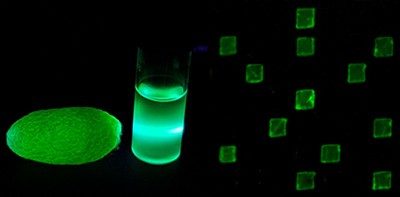FOR IMMEDIATE RELEASE | April 13, 2022
Edible, fluorescent silk tags can suss out fake medications
“Edible Matrix Code with Photogenic Silk Proteins”
ACS Central Science
Recent developments such as the explosion of online pharmacies and supply chain issues have made it easier for counterfeiters to profit from fake or adulterated medications. Now, researchers reporting in ACS Central Science have created edible tags with fluorescent silk proteins, which could be placed directly on pills or in a liquid medicine. The codes within the tags can be read by a smartphone app to verify the source and quality of these pharmaceuticals.
Online pharmacies have taken off in recent years, delivering many types of medications directly to consumers’ homes. Some of these businesses are legitimate, but others operate illegally, supplying counterfeit drugs that are substandard, incorrectly labeled or laced with unwanted components. In addition, global supply chain problems have made it easy for fake medications to infiltrate the market. To instill trust in consumers, pharma companies label the outside packaging of their products with bar codes, QR codes, holograms and radio frequency identifiers, allowing distributors and retailers to manage products throughout the supply chain. Yet there aren’t equivalent codes for consumers to verify the source of individual pills or liquid doses inside a container. Researchers have developed fluorescent synthetic materials, such as microfibers and nanoparticles, as tracking codes, but the substances are potentially unsafe to consume. So, Seong-Wan Kim, Young Kim and colleagues wanted to see whether silk, which is an edible and “generally recognized as safe” material, could be placed directly onto medications and made to fluoresce, helping consumers make sure their purchases are what they claim to be.
The researchers genetically modified silkworms to produce silk fibroins — edible proteins that gives silk fibers their strength — with either a cyan, green or red fluorescent protein attached. They dissolved the fluorescent silk cocoons to create fluorescent polymer solutions, which they applied onto a thin, 9-mm-wide film of white silk in a seven-by-seven grid. Shining blue violet, blue, and green light onto the grid revealed the 3D cyan, green and red square patterns, respectively. Using optical filters over the phone’s camera, an app the team designed can scan the fluorescent pattern, decoding the digitized key using a deep learning algorithm and opening up a webpage, which could host information about the drug’s source and authenticity. And because some liquid medications are alcohol-based, the researchers placed a coded silk film in a clear bottle of Scotch whisky, and found that the fluorescent code was still readable with the app. Finally, the researchers showed that the fluorescent silk proteins are broken down by gastrointestinal enzymes, suggesting that the silk codes are not only edible but also can be digested by the body. The researchers say that placing these edible code appliqués onto pills or in liquid doses could empower patients and their care providers to avoid the unintentional consumption of fake treatments.
The authors acknowledge funding from the Cooperative Research Program for Agriculture Science & Technology Development from Rural Development Administration of the Republic of Korea, the U.S. Air Force Office of Scientific Research and the Trask Innovation Fund from Purdue University.
To automatically receive press releases from the American Chemical Society, contact newsroom@acs.org.
Note: ACS does not conduct research, but publishes and publicizes peer-reviewed scientific studies.
Media Contact
ACS Newsroom
newsroom@acs.org
View larger image


